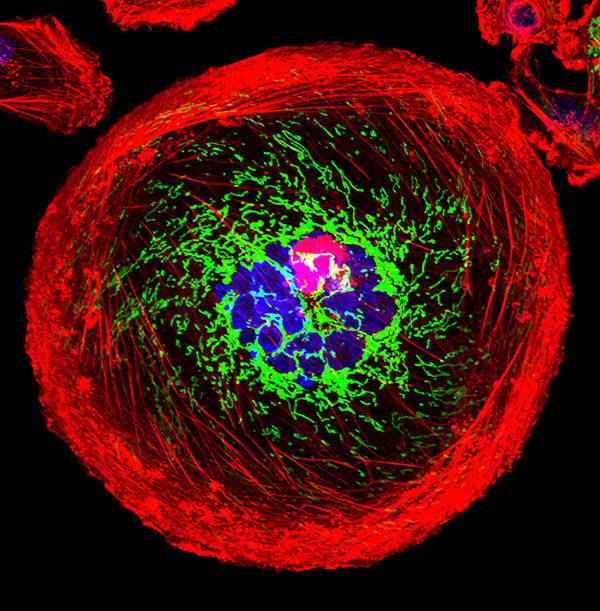07/11/2019 12:03 PM EDT
Advances in Breast Cancer Research
NCI-funded researchers are working to advance our understanding of how to prevent, detect, and treat breast cancer. They are also looking at how to address disparities and improve quality of life for survivors of the disease.
This page highlights some of the latest research in breast cancer, including clinical advances that may soon translate into improved care, NCI-supported programs that are fueling progress, and research findings from recent studies.
Early Detection of Breast Cancer
Breast cancer is one of a few cancers for which an effective screening test, mammography, is available. MRI (magnetic resonance imaging), ultrasound, and clinical breast exams are also used to detect breast cancer, but not as routine screening tools.
Ongoing studies are looking at ways to enhance current breast cancer screening options. Technological advances in imaging are creating new opportunities for improvements in both screening and early detection.
One new technology is 3-D mammography, also called breast tomosynthesis. This procedure takes images from different angles around the breast and builds them into a 3-D-like image. Although this technology is increasingly available in the clinic, it isn’t known whether it is better than standard 2-D mammography, for detecting cancer at a less advanced stage.
NCI is funding a large-scale randomized breast screening trial, the Tomosynthesis Mammographic Imaging Screening Trial (TMIST), to compare the number of advanced cancers detected in women screened for 5 years with 3-D mammography with the number detected in women screened with 2-D mammography.
Two concerns in breast cancer screening, as in all cancer screening, are the potential for diagnosing tumors that will not become life-threatening (overdiagnosis) and the possibility of receiving false-positive test results. As cancer treatment is becoming more individualized, researchers are looking at ways to personalize breast cancer screening. They are studying screening methods that are appropriate for each woman’s level of risk and limit the possibility of overdiagnosis.
For example, the Women Informed to Screen Depending on Measures of Risk (WISDOM)study aims to determine if risk-based screening—that is, screening at intervals that are based on each woman’s risk as determined by her genetic makeup, family history, and other risk factors—is as safe, effective, and accepted as standard annual screening mammography.
Breast Cancer Treatment
The mainstays of breast cancer treatment are surgery, radiation, chemotherapy, hormone therapy, and targeted therapy. But scientists continue to study novel treatments and drugs, along with new combinations of existing treatments.
It is now known that breast cancer can be divided into subtypes that respond differently to various types of treatment. The three main clinical subtypes of breast cancer are:
- Hormone receptor (HR) positive. HR-positive breast cancers are those that contain the estrogen receptor (ER) and/or progesterone receptor (PR). These cancers grow in response to these hormones and can be treated with hormone therapies.
- Human epidermal growth factor receptor 2 (HER2) positive. HER2-positive breast cancers are those that have high amounts of the HER2 protein; they can be HR positive or HR negative. These cancers can be treated with therapies that target HER2.
- Triple-negative breast cancer. Such cancers do not contain ER, PR, or HER2.
As we learn more about the subtypes of breast cancer and their behavior, we can use this information to guide treatment decisions. One example of this is the NCI-sponsored TAILORx clinical trial. The study, which included patients with ER-positive, lymph node-negative breast cancer, found that a test that looks at the expression of certain genes can predict which women can safely avoid chemotherapy.
Genomic analyses, such as those carried out through The Cancer Genome Atlas (TCGA), have helped reveal the molecular diversity of breast cancer and eventually could help identify even more breast cancer subtypes. That knowledge, in turn, may lead to the development of therapies that target the genetic alterations that drive those cancer subtypes.
Few drugs are currently available that target specific genetic mutations in breast cancer, although this is an active area of research. But the Food and Drug Administration (FDA) has approved several targeted therapies for breast cancer that block the action of specific cell-growth molecules, and more are in development.
HR-Positive Breast Cancer Treatment
Targeted therapy uses drugs or other substances to attack cancer cells with less harm to normal cells. There is a new focus on adding targeted therapies to hormone therapy for advanced or metastatic HR-positive breast cancer. These treatments could prolong the time until chemotherapy is needed and ideally, extend survival. Several new targeted drugs are being tested in the metastatic setting for HR-positive breast cancer:
- Palbociclib (Ibrance), ribociclib (Kisqali), and everolimus (Afinitor) have all been approved by the FDA recently for use with hormonal therapy for treatment of advanced or metastatic breast cancer
- Abemaciclib (Verzenio) can be given with hormonal therapy or alone after treatment with hormonal therapy to women with advanced or metastatic ER-positive, HER2-negative breast cancer. These combinations are also being tested to see if they can a prevent relapse after treatment of early-stage ER-positive disease.
HER2-Positive Breast Cancer Treatment
The FDA has approved a number of targeted therapies to treat HER2-positive breast cancer, including:
- Trastuzumab (Herceptin) and pertuzumab (Perjeta) can be used in combination with chemotherapy for both early and advanced breast cancer.
- Ado-trastuzumab emtansine (Kadcyla) is an FDA-approved treatment for advanced HER2-positive breast cancer.
- Lapatinib (Tykerb) has been approved for treatment of HER2-positive metastatic breast cancer. However, a study that tested adding lapatinib to chemotherapy and trastuzumab to treat early-stage breast cancer did not show a significant improvement in outcomes.
- Neratinib Maleate (Nerlynx) was shown to improve outcomes in patients with early-stage HER2-positive breast cancer when given for one year after completion of standard adjuvant treatment with chemotherapy.
- Trastuzumab has been approved to prevent a relapse in patients with early-stage HER2-positive breast cancer.
HER2-positive metastatic breast cancer is more likely to spread to the brain than other types of breast cancer. HER2-targeted drugs that can cross the blood-brain barrier are currently being studied for the treatment and prevention of brain metastases.
Triple-Negative Breast Cancer
Triple-negative breast cancers (TNBC) are the hardest to treat because they lack both hormone receptors and HER2 overexpression, so they do not respond to therapies directed at these targets. Therefore, chemotherapy is the mainstay for treatment of TNBC. Ongoing studies are testing new treatments for this type of breast cancer, such as:
- PARP inhibitors work by blocking a protein that is used to repair damage to DNA that occurs during cell division. They are effective drugs that target TNBC caused by inherited BRCA gene mutations or other alterations that lead to defects in DNA damage repair. They are also approved for metastatic ER-positive, HER2-negative breast cancers in patients who have inherited a harmful BRCA gene mutation. These drugs are currently being studied for treatment of TNBCs that are not caused by an inherited mutation in the BRCA gene.
- Immunotherapy drugs have shown some promise in a small number of breast cancers, particularly those that are triple negative. Some data suggest that patients may be more likely to respond to immunotherapy if their tumor expresses the protein PD-L1 or if it has a large number of mutations.
- Scientists are also studying whether combining a variety of drugs with immunotherapy will work better than immunotherapy alone. One recent study of the drug atezolizumab (Tecentriq)Tecentriq), in combination with chemotherapy, showed promising results in patients with metastatic TNBC that expressed the PD-L1 protein.
- Drugs that block the androgen receptors (AR) or prevent androgen production are being tested in a subset of TNBC cancers that express the AR.
NCI-Supported Research Programs
See a full list of breast cancer research projects that NCI funded in FY 2017.
Many NCI-funded researchers working at the NIH campus, as well as across the United States and world, are seeking ways to address breast cancer more effectively. Some research is basic, exploring questions as diverse as the biological underpinnings of cancer and the social factors that affect cancer risk. And some are more clinical, seeking to translate this basic information into improving patient outcomes. The programs listed below are a small sampling of NCI’s research efforts in breast cancer.
Early Detection and Treatment Research
The Breast Specialized Programs of Research Excellence (Breast SPOREs) are designed to quickly move basic scientific findings into clinical settings. The Breast SPOREs support the development of new therapies and technologies, and studies to better understand tumor resistance, diagnosis, prognosis, screening, prevention, and treatment of breast cancer.
The NCI Cancer Intervention and Surveillance Modeling Network (CISNET) focuses on using modeling to improve our understanding of how prevention, early detection, screening, and treatment affect breast cancer outcomes.
The Confluence Project, from NCI's Division of Cancer Epidemiology and Genetics, will develop a research resource that includes data from thousands of breast cancer patients and controls of different races and ethnicities. This resource will be used to identify genes that are associated with breast cancer risk, prognosis, subtypes, response to treatment, and second breast cancers.
The goal of the Breast Cancer Surveillance Consortium (BCSC), an NCI-funded program launched in 1994, is to enhance the understanding of breast cancer screening practices in the United States and their impact on the breast cancer's stage at diagnosis, survival rates, and mortality.
There are ongoing programs at NCI that support prevention and early detection research in different cancers, including breast cancer. One example is the Cancer Biomarkers Research Group, which promotes research in cancer biomarkers and manages the Early Detection Research Network (EDRN). EDRN is a network of NCI-funded institutions that are collaborating to discover and validate early detection biomarkers.
The Consortium for Imaging and Biomarkers (CIB) and the Consortium for Molecular Characterization of Screen-Detected Lesions are programs that research which screen-detected lesions are areas of concern and which can be left alone. The goal of the programs is to give physicians a better idea whether regular monitoring is sufficient or if early treatment is warranted.
Health Disparities Research
Black women are more likely to be diagnosed with aggressive subtypes of breast cancer, and they are more likely to die of their disease than white women. To gain an understanding of these disparities, NCI is funding a multi-institution project, the Breast Cancer Genetic Study in African-Ancestry Populations. The genes of black women with and without breast cancer will be compared to each other, as well as to those of white women who have breast cancer.
The NCI-funded Detroit Research on Cancer Survivors (Detroit ROCS) study will look at the major factors affecting cancer progression, recurrence, mortality, and quality of life among African-American survivors of four different cancers, including breast. Detroit ROCS will examine medical, emotional, social, environmental, and other factors that may affect cancer survival.
Survivorship Research
NCI’s Office of Cancer Survivorship, part of the Division of Cancer Control and Population Sciences (DCCPS), supports research projects throughout the country that study many issues related to breast cancer survivorship. Examples of studies funded include the impact of cancer and its treatment on physical functioning, emotional well-being, cognitive impairment, sleep disturbances, and cardiovascular health. Other studies focus on financial impacts, the effects on caregivers, models of care for survivors, and issues such as racial disparities and communication.
Clinical Trials
NCI funds and oversees both early- and late-phase clinical trials to develop new treatments and improve patient care. Trials are available for breast cancer prevention, screening, and treatment.
Breast Cancer Research Results
The following are some of our latest news articles on breast cancer research and study updates:
- Low Rates of Genetic Testing in Ovarian, Breast Cancer
- FDA Approves Atezolizumab for Triple-Negative Breast Cancer
- Improving Immunotherapy for Metastatic Breast Cancer
- Sensitizing Dormant Tumor Cells to Chemotherapy
- Two Radiation Therapy Approaches Prevent Breast Cancer Recurrences
View the full list of Breast Cancer Research Results and Study Updates.

























.png)











No hay comentarios:
Publicar un comentario